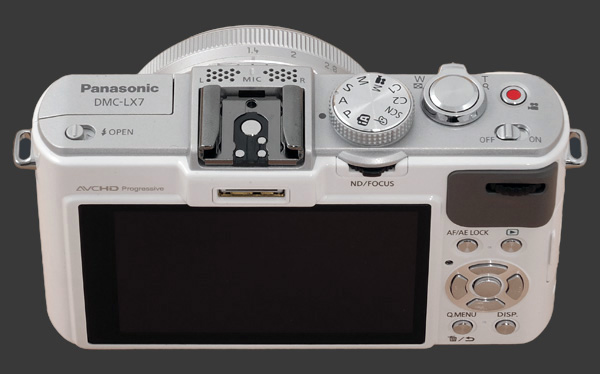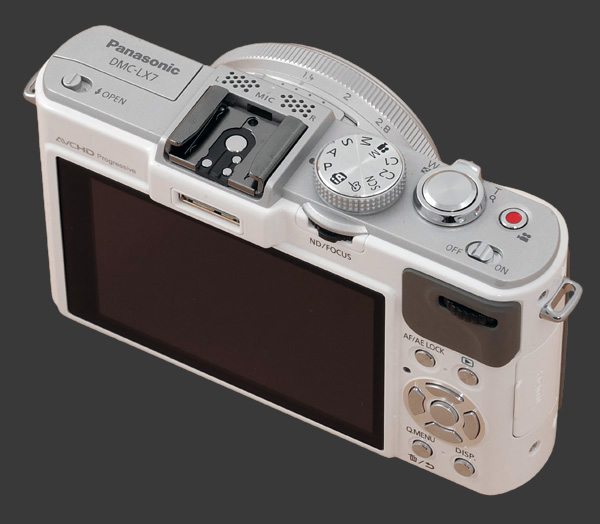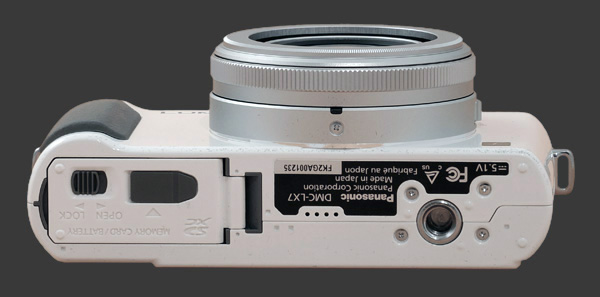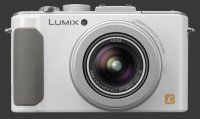Panasonic Lumix DMC-LX7 Review
Panasonic Lumix DMC-LX7 Introduction
The Panasonic Lumix DMC-LX7 is a premium compact camera with the brightest ultra-wide-angle lens of any digital camera, equivalent to 24-90mm F/1.4 - 2.3. This camera has a larger-than-usual 10 megapixels CMOS sensor capable of ISO 80 to 6400 at full resolution. It can record full 1080p HD video progressively at 60 FPS and continuously shoot at 11 FPS.
The LX7 is designed for advanced photographers looking for efficient manual controls in a compact camera. This can be people looking for a compact model where larger equipment is cumbersome or beginners looking to learn photography. For either type of user, this digital camera offers full manual-controls including manual-focus, choice of metering patterns including Spot and custom white-balance.
This camera has provides more external controls and expansion options than most fixed-lens cameras. There is a hot-shoe for external lighting and an accessory port that supports an optional EVF to allow eye-level shooting. An aperture ring around the lens acts as second control-dial, complementing the one on the back of the camera.
This camera review covers the usability and performance of the Panasonic Lumix DMC-LX7.

Panasonic Lumix DMC-LX7 Features
Sensor & Exposure
- 10 Megapixels CMOS sensor
- ISO 80 - 12800 sensitivity at full-resolution
- ISO 12800 at 3 megapixels
- Auto ISO based on light-levels and movement
- 1/4000 - 250s Shutter-speeds
- PASM Exposure modes for both stills and video
- Exposure-Compensation, ±3 in 1/3 EV increments
- Multi-Segment, Center-Weighed and Spot metering modes
Lens
- Ultra-Wide 24 - 90mm equivalent 3X optical zoom
- F/1.4 - 2.3 Maximum aperture, F/8 Minimum
- Optical image stabilization
- 50cm Normal minimum focus distance
- 1cm (W) - 30m (T) Macro minimum focus distance
Image Parameters
- Automatic, 5 presetsDaylight, Cloudy, Shade, Flash, Incandescent, Kelvin and custom white-balance, 2 memories
- WB fine-tuning, 19 steps along 2 axis
- White-Balance bracketing, 3 frames
- Standard, Vivid, Natural, Monochrome, Scenic and Portrait color modes
- Adjustable Contrast, Sharpness, Saturation, Noise-Reduction, 5 steps each
- JPEG, RAW or RAW+JPEG output
Focus
- Normal, Macro and Manual focus modes
- Single, Automatic, Tracking and Face-Detect focus-point selection
- Prefocus: Off, Quick or Continuous
- Manual Focus assist
- AF Assist-Lamp
Drive
- Single-Shot drive mode
- Self-Timer: 2s, 10s or 3 shots @ 10s
- 11 FPS AF-S Only, 5 FPS AF-S or AF-C
- 40 FPS @ 5 MP
- 60 FPS @ 2.5 MP, reduced field-of-view
- 1 FPS Flash Burst @ 3 MP, AF-S Only
- Exposure Bracketing, 3 frames, maximum ±3 EV
- White-Balance Bracketing, 3 frames, 3 steps sizes along one of two axis
- Multiple-Exposure, maximum 3 frames, optional Auto-Gain
- Time Lapse, 1 - 30 min intervals, 10 - 60 frames
- Aspect Ratio Virtual Bracket, always 4 frames
Display & Viewfinder
- 3" LCD, 920K Pixels
- Optional 0.2" EVF, 200K Pixels
- Adjustable LCD brightness
- Adjustable LCD contrast-saturation
- Adjustable LCD colors
- Optional framing grid
Video
- 1920x1080 @ 60 FPS AVCHD
- 1920x1080 @ 30 FPS MPEG-4
- AF-S or AF-C focus
- Optional wind-filter
- Optional stabilization
- Optional video framing mask
Flash
- Flash-Compensation, ±2 in 1/3 EV increments
- Auto, Auto Redeye, Forced, Redeye & Slow-Sync flash modes
- First or Rear curtain flash sync
- Optional Redeye reduction
- Flash Hot-Shoe
Connectivity
- Stereo Sound input
- HDMI (1080i) output
- A/V (NTSC / PAL) output
- USB 2.0 connectivity
Misc
- 4:3, 3:2, 16:9 & 1:1 Aspect-Ratio
- Aperture ring on lens barrel
- Rear generic control-dial
- Combined AE-L/AF-L button
- Customizable Fn button
- Built-in ND8, 3-stop ND filter
- Manual Focus rocker, combined with ND activator
- Sweep Panorama mode
- Builtin HDR mode
- 16 Scene-Modes
- Optional Face Recognition
- Lithium-Ion battery
- SDXC memory
Panasonic Lumix DMC-LX7 Usability - How easy is it to use?
The Panasonic Lumix DMC-LX7 is a compact digital camera with a protruding lens barrel and plenty of external controls. The camera is comfortable to hold thanks to a small rubberized hand-grip. Since the fixed portion of the lens barrel is surrounded by the aperture ring and two sliding switches, the LX7 really requires two-handed operation. This is a good thing since it gives the camera extra stability. Further stability is possible by using it at eye-level with an optional 1.4 megapixels EVF sold separately.
The lens barrel extends almost 1" from the front plate and, when powered on, extends 1 - 1½" further, according to the zoom. When powered off, the lens can be protected by a removable lens cap, possibly tethered to one of the camera-strap eyelets. There are eyelets on both sides of the camera for the supplied neck-strap. Given its small size, the LX7 can be easily used with a wrist-strap instead. The LX7 is sophisticated enough to detect and display an appropriate message if the lens cap is attached when the camera is powered on.

The aperture ring which is effectively a control-dial dedicated to aperture has good detents with audible clicks. It is marked with aperture values from F/1.4 to F/8. Unlike a traditional lens, the position of the aperture ring is fly-by-wire and the camera completely ignores it in all modes except A and M. Furthermore, since the Panasonic LX7 has a variable-aperture lensA lens which changes its maximum aperture according to the zoom., values below F/2.3 are clamped to the maximum aperture allowable by the lens at its current zoom. For example, at 2X zoom or an equivalent of 48mm, aperture values below F/1.8 are ignored. Other cameras avoid the issue by not labelling aperture values.
Still on the lens barrel, just behind the aperture ring, there are two switches. The one on top selects the aspect ratio of images captured by the LX7. There are four options: 1:1, 4:3, 3:2 and 16:9 which correspond to a square image, the aspect-ratio of fixed-lens camerasNearly all fixed-lens cameras capture 4:3 images natively. Exceptions are ones with large sensors such as the Fuji Finepix X100 and the Sigma DP-series., the standard aspect-ratio of ILCsAll DSLRs and SLDs except those by Olympus and Panasonic use the same 3:2 aspect ratio. and the aspect-ratio of typical wide-screen HD televisions, respectively.
The slider is easy to use and encourages changing the aspect-ratio to fit the scene. The only issue is that it is easy to accidentally move the switch while changing apertures. The LX7 uses a large sensor area to keep the diagonal angle-of-view constant, except for square images. It drops its maximum resolution according to the selected aspect ratio: 9.5 MP for 3:2, 9 MP for 16:9 and 7.5 MP for 1:1.
On the side of the lens barrel is a 3-way switch to choose between Normal AF, Macro AF and Manual Focus. This one has slightly firmer detents and is less prone to accidental changes. Once the focus mode is set, a button on the back of the camera - covered further down on this review page - control focusing.

The top of the Panasonic Lumix DMC-LX7 is nearly identical to its predecessor, the LX5 reviewed here. Starting on the right, there is a small sliding power-switch. Above it, a dedicated video-recording button is found. This is actually redundant since there is a Movie mode which uses the shutter-release to start and stop. Filming in all other modes is possible too. To properly frame videos, an optional mask greys out areas not captured on video. Still, it can be hard to see, depending on what is shown on the display, so Movie mode is the most reliable way of framing videos.
A standard two-stage shutter-release with a distinct halfway point is next to the video-recording button. Around it is the zoom controller which moves the lens at a leisurely pace in 19 increments. The steps are fine at the wide-end but coarse towards the telephoto end, making precise framing difficult. To the left of it is a traditional mode dial with good audible detents. All PASM modes are there, plus iAuto, Creative Control mode, Scene mode, two Custom modes and Movie mode. Movie mode has PASM sub-modes too.
The SCN position of the mode-dial adds a menu to select a particular Scene mode. There are 16 options to choose from with the usual suspects plus a few noteworthy ones:
- Panorama Shot: This is what others call Sweep Panorama which creates a low resolution panorama covering up to 360° right in the camera. To capture it, press the shutter and move the camera in a steady motion. The LX7 requires a rapid sweeping pace which prevents the use of this mode in low-light. Sweeping too slow, or too fast, prematurely terminates the panorama.
- Night Scenery and Hand-Held Night Shot are both night scene modes with the important distinction that the former uses a low ISO and long shutter-speed, up to 8s, while the latter uses a high-ISO to obtain a faster shutter-speed.
- 3D: The camera creates a 16:9 aspect 3D images for showing on 3D-capable televisions. The resolution is fixed at 2MP which equates to 1080p. The capture happens by sweeping the camera a short horizontal distance.
- HDR: Automatically creates an HDR image from 3 quick consecutive shots. The field-of-view of the output is slightly adjusted as needed to align images. The HDR mode on the LX7 is one of the best ones and usually produces relatively natural looking images which good sharpness. Take a look at typical outdoor scene:
The combined hot-shoe and accessory port are next to the mode-dial. Only one accessory can be connected at a time, so its either the optional EVF, an add-on flash, external microphone or other item. Just above the hot-shoe is a built-in stereo microphone. Further left is the flash-release button which works exactly as expected.
The rear of the LX7 is dominated by a 3" LCD with 920K pixels. The LCD is sharp with an excellent anti-reflective coating. The LCD is highly customizable and can be calibrated in terms of Tint along 2 axis in 11 fine steps. The display Contrast and Saturation are adjustable together in 7 steps, as is brightness. This is great functionality to have and we are glad to see it on a compact camera.
The rear LCD shows a bright view of the subject until the shutter-release is pressed halfway when it becomes Exposure-Priority temporarily. When the Live-Histogram is shown, it is calculated from the display brightness, making it useless until the shutter-release is pressed halfway. While it would be preferable to always have an Exposure-Priority display, the histogram should only be shown when correct. Instead, it simply turns an orange color while occluding part of the frame, making it worse than useless. At least it can be turned off completely.

The remaining area to the right of the LCD is covered with controls, leaving a small spot below the control-dial to place the thumb. The only control-dial is clickable so that it can cycle between several functions. One of those functions is EC. While this saves the space needed for a dedicated EC button, it is fiddly and error-prone since camera operations become modal.
Above the LCD, just below the mode-dial, is a new clickable rocker switch. Clicking it toggles the built-in 3-stop ND filter. Moving it left or right adjusts focus distance in Manual Focus mode. Clicking it while adjusting focus changes the magnification of the MF Assist feature, if enabled.
Further below the control-dial, there is a 4-way controller made of 5 separate buttons including the central OK. The controller is used to navigate menus and activate important functions:
- Up: Selects the ISO. There are two automatic options, one depending on light levels and the other, called Intelligent ISO, depending on light and subject movement.
- Right: Selects White-Balance, including Kelvin temperature and two Custom WB memories. Both WB Fine-Tuning and Bracketing are accessible from there.
- Down: Selects the Drive mode, including Single-Shot, Continuous Shooting with eight sub-options, AEB and Self-Timers. There is one 2s Self-Timer and two 10s ones, one which takes a single shot and the other that takes three.
- Left: By default, enters focus area control mode. In this mode the directions move the focus area around until OK is pressed. This can be customized to perform one of 14 functions instead, including selecting the Metering mode.
The eight continuous drive modes, described in the table below. AF-S means that focus is locked on the first frame. AF-C means that focus is adjusted for each frame.
| Speed | Focus | Maximum Burst | Maximum Resolution | Notes |
|---|---|---|---|---|
| 2 FPS | AF-S | Card capacity | 10 MP | Mechanical shutter. |
| 2 FPS | AF-C | Card capacity | 10 MP | Mechanical shutter. |
| 5 FPS | AF-S | 24 | 10 MP | Mechanical shutter. |
| 5 FPS | AF-C | 24 | 10 MP | Mechanical shutter. |
| 11 FPS | AF-S | 12 | 10 MP | Mechanical shutter. |
| 40 FPS | AF-S | 40 | 5 MP | Electronic shutter. Bursts grouped for playback. |
| 60 FPS | AF-S | 60 | 2.5 MP | Reduced field-of-view. Electronic shutter. Bursts grouped for playback. |
| 1 FPS | AF-S | 5 | 3 MP | Flash fire for each frame. |
There are two buttons above and two below the 4-way controller. Above are the customizable AE-L/AF-L and Playback buttons. Below are the Display and Quick Menu buttons. AE-L/AF-L can lock exposure, focus or both. The Quick Menu button enters a graphic menu to change Color Mode, Flash Mode, Video Resolution, Image Resolution, Image Quality, AF Mode, Metering Mode and EC.

The bottom of the LX7 has a rather poorly placed tripod mount and a flimsy door covering the combined battery and SDXC card compartment. The remainder of the camera is actually well-built and feels solid though.
The Panasonic Lumix DMC-LX7 is pleasant to use, with the exception of the modal Exposure-Compensation control. It is always important to note the color of the exposure-meter to see if you are already in EC mode or you need to click the rear control-dial to get there. That control-dial is also not so responsive. The front one though is very nice and its detents give a perfect feedback. Nicely, this camera is able to keep responding to adjustments while images are being recorded.
 |
Please Support Neocamera
All information on Neocamera is provided free of charge yet running this website is a huge endeavor. Purchases made via affiliate links found throughout the site help keep it running and up-to-date. There is no additional cost to you, so please consider buying via these links to our affilates:
If you found any information on this site valuable and did not purchase via our affiliate links, please considering donating via PayPal:
Any amount will be greatly appreaciated. Thank you for your support!
Panasonic DMC-LX7 Highlights

Sensor-Size: 8 x 6mm

Actual size when viewed at 100 DPI
| 10 Megapixels Fixed Lens | ISO 80-6400 |
| 3.8X Ultra-Wide Optical Zoom | Shutter 1/4000-250s |
| Built-in Stabilization | Full manual controls, including Manual Focus |
| 0.44" Optional EVF 1.4 Megapixels | Custom white-balance with 2 axis fine-tuning |
| 2 Axis Digital Level | Spot-Metering |
| 11 FPS Drive, 12 Images | Hot-Shoe |
| 1920x1080 @ 60 FPS Video Recording | Lithium-Ion Battery |
| 3" LCD 920K Pixels | Secure Digital Extended Capacity, Internal Memory |
Updates
2025.01.18

Fujifilm GFX 2025 Lens Roundup
Lens Review roundup of Fujifilm GFX Medium-Format lenses. Quality, performance and handling of the GF20-35mm F/4R WR, GF30mm F/3.5 Tilt-Shift and the GF55mm F/1.7.
2024.11.18

Best 2024 Photography Gifts for Every Budget
Great gifts for photographers and photo enthusiasts selected for every budget among the best products of 2024.
2024.08.07

Eye Protection Tips for Professional Photographers
The four main considerations for professional photographers regarding eyewear.
2024.07.14

Fujifilm X100VI Review
Flagship fixed-lens compact digital camera with a 40 MP sensor and Image-Stabilization, a first for the series. Retro design featuring dual control-dials, plus direct ISO, Shutter-Speed and EC dials. Its hybrid viewfinder can switch between EVF and OVF mode.
2024.05.09

Fujifilm GFX100 II Review
Flagship 102 Megapixels Medium-Format Mirrorless Digital Camera with 8-Stop 5-Axis IBIS, 8 FPS Drive, 8K Video and 400 MP Super-Resolution capture in a weatherproof and freezeproof body with dual control-dials and dual memory-card slots.
2024.04.03

Fujifilm X-T5 Review
Newest Fujifilm flagship boasting a 40 MP APS-C sensor, 5-axis IBIS with 7-stop efficiency, 15 FPS continuous drive, 6.2K Video capture, dual control-dials and dual SDXC UHS-II slots in a sturdy weatherproof and freezeproof body.
2023.11.20

Best Digital Cameras of 2023
Find out which are the Best Digital Cameras of 2023. All the new Mirrorless Digital Cameras from entry-level to high-end professional.
2023.07.10

Fujifilm X-H2 Review
40 Megapixels APS-C Hybrid Mirrorless Digital Camera with 7-stop IBIS. Fastest shutter ever and 8K video capture. Large builtin EVF with 0.8X magnification and 5.8 MP, plus an Eye-Start Sensor. Packed with features and large number of controls in a weatherproof and freezeproof body.
2023.05.07

Sony FE 20-70mm F/4G Review
Review of the unique Sony FE 20-70mm F/4G lens. The optical zoom of this lens spans ultra-wide-angle and medium focal-length coverage, making it one of the most versatile Full-Frame lenses on the market.
2023.01.15

Huion Inspiroy Dial 2 Review
Review of the Huion Inspiroy Dial 2 tablet, a medium sized drawing surface with dual dials and customizable buttons. Connects via USB-C or Bluetooth 5.0 with Windows, Linux and Android support.
2022.12.08

How to Pack for a Photo Trip
Find out how to pack for a travel photography trip, carry your gear safely while meeting airline regulations.
2022.11.13

Best Digital Cameras of 2022
The best digital cameras of 2022. A short list of the most outstanding models in their respective categories. Choose one for yourself or as a gift.













